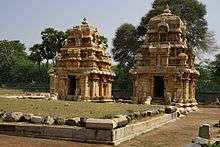Boothi Vikramakesari
Boothi Vikramakesari was a Velir Irukkuvel chieftain and a feudatory of the medieval Cholas. He is best remembered for building the Moovar Koil temple complex, a collection of "Three temples" in the village of Kodumbalur, 36 kilometres from Pudukkottai in Tamil Nadu, India. His family was related to the Cholas by marriage. His mother was a Chola princess while his daughter married Chola prince Arindama.[1]

Dating
Some scholars and historians identify him as a contemporary of Parantaka I while some others like Venkayya identify him as a sub-ordinate of Sundara Chola Parantaka II.[2] It is more likely that he was a feudatory of Parantaka I as a daughter of his, namely Boothi Aditya Pidaari was married to Arikulakesari, the younger son of Parantaka I.[1]
Moreover, the chief and his family members figure in inscriptions of the Pallava King Vijaya Nandivikramavarman and later in inscriptions of Aditya I, so he seems to have initially been a sub-ordinate of the Pallava King and then a feudatory of the Chola King Aditya I after the latter overthrew the former's son Aparajita. Subsequently, he seems to have continued in service of Aditya I's son Parantaka I. Consequently, his period can be fixed between the latter half of 9th century and beginning of the 10th century.[3][4]
Personal life
The chief's given name was Boothi and he earned the title Vikramakesari through his exploits.[5] He is also called as Tennavan Ilangovel and Parantaka Ilangovelir in inscriptions.[1] He was born to Irukkuvel chieftain Samarabirama and Chola princess Anupama. Samarabirama is called Yadu vamsa kethu that is the Banner of the Yadu race in the Moovar Koil inscription[6] Two queens of his are known from the same inscription, namely, Nangai Varaguna Perumanar and Karrali.[7] As mentioned earlier, a daughter of his, namely Boothi Aditya Pidaari was married to Arikulakesari, the younger son of Parantaka I. She is known from an inscription from a temple at Tiruchendurai.[1]
Inscriptions
An excerpt of the Moovar Koil inscription is as follows,
.. there was (called) Anupama (meaning peerless), (who) was literally true to her name, a daughter of the Chola king, and a beloved of this Yadu vamsa kethu(Banner of the Yadu race, that is Samarabirama) Of her was born to him the glorious king called Bhuti otherwise called Minnamala Vikramakesari (the Lion of Valour).
Another inscription from the period of Pallava King Vijaya-Nandivikramavarman from Kilur, Tirukovilur taluk, South Arcot district. The script and language of the inscription is in Tamil and paleographically the inscription can be dated to the 9th century,
..the inscription is dated in the sixteenth year of the Ko Vijaya Nandivikramavarman and records the gift by Maravan Pudi alias Tennavan Ilangovelar. The gift consisted of 24 kalanju of pure gold weighed by videlvidigu, the standard stone, out of the interest of which the Nagarattar of Tirukkovalur undertook to supply ghee for burning a lamp.[3]
The following is another inscription from Ghrithasthaneswara temple in Tillasthanam, figuring the queen of Boothi Vikramakesari from the period of Aditya I,[8]
(Line 1) Hail Prosperity, in the 13th year of the reign of King Rajakesarivarman, Tennavan Pirudimarsan alias Katti Orri-uran gave 25 kalanju of gold for burning one perpetual lamp with (one) ulakku of ghee everyday the (god) Mahadeva (Siva) at Tiruneyttanam which was a devadana in Poygainadu; and Varaguna Perumanar the queen(deviyar) of Parantaka Ilangovelar gave 25 kalanju of gold for one perpetual lamp. With this total of 50 kalanju of gold (some) lands of the god were cleared of its borders and mounds and were converted into a wet field. The boundaries of (the reclaimed) these lands are:-.. (L 7) West of the cultivated land of the (god) Vishnu Bhattaraka (lying to) the east of the border; north of the embankment called Karikala-karai; east of the karay dry lands of the god; south of the (channel called) Andanur-vaykkal.[4]
It is of interest to note that among the boundaries mentioned in the above inscription there is an embankment called Karikala-karai.[4]
References
- Museums Association of India (1964). Journal of Indian Museums, Volumes 17-20. Museums Association of India. p. 13.
- Shyam Singh Shashi (2000). Encyclopaedia Indica: South India, Volume 89 of Encyclopaedia Indica: India, Pakistan, Bangladesh. Anmol Publications. p. 291.
- Archaeological Survey of India, India. Dept. of Archaeology, India. Archaeological Survey (1987). Epigraphia Indica, Volume 32. Manager of Publications. pp. 99–100.CS1 maint: multiple names: authors list (link)
- Rao Sahib H. Krishna Sastri (1987). South Indian Inscriptions, Volume III, Miscellaneous inscriptions from the Tamil Country. The Director General, Archaeological Survey On India, Janpath, New Delhi. pp. 249–250.
- S. Swaminathan (1998). The early Chōḷas history, art, and culture. Sharada Pub. House. p. 65.
- S. Swaminathan (1998). The early Chōḷas history, art, and culture. Sharada Pub. House. p. 33.
- Madras (India : State); B. S. Baliga (1983). Madras District Gazetteers: Pudukkottai District. Superintendent, Government Press. p. 802.
- S. R. Balasubrahmanyam (1971). Early Chola Temples: Parantaka I to Rajaraja I, A.D. 907-985. Orient Longman. p. 116.